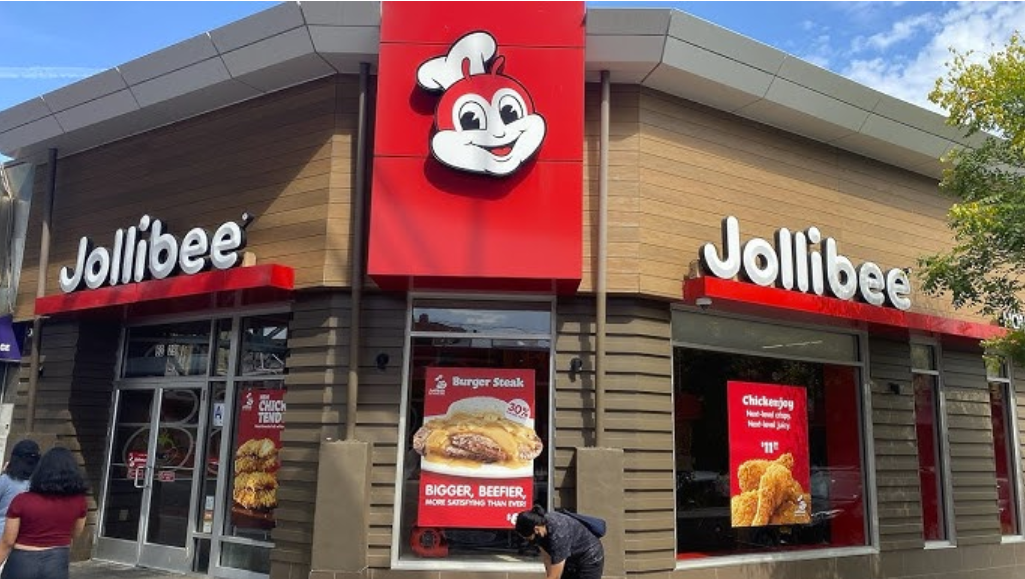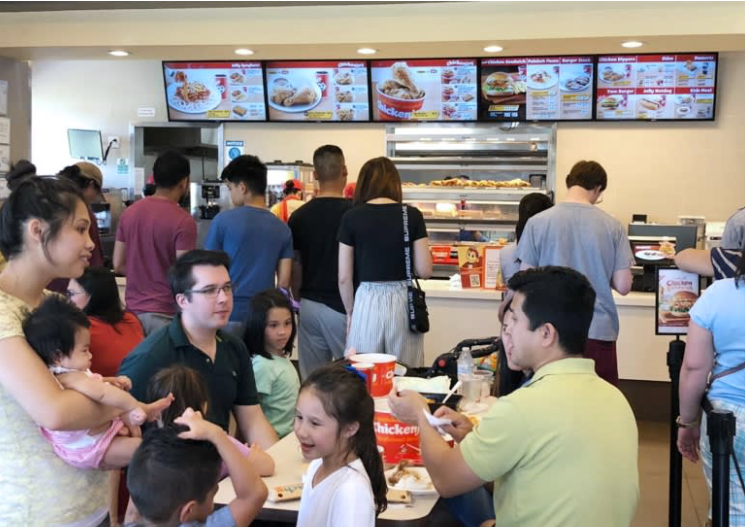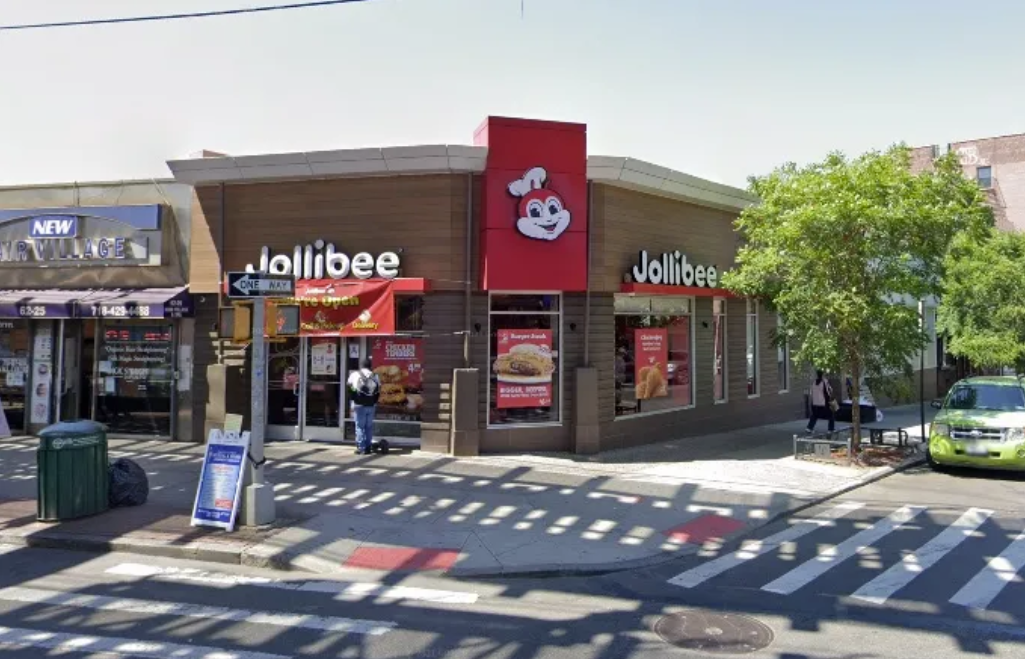For many Filipinos across the world, Jollibee isn’t just a fast-food chain restaurant—it is a piece of Philippines: home, culture, and community, all wrapped in colors of red and yellow. From the famous Chickenjoy’s familiar “crispylicious” and “juicylicious” crunch to the sweet spaghetti, Jollibee brings both nostalgia and identity. It bridges cultural divides and fosters a sense of belonging, even far from home.
Jollibee in Jackson Heights

Walk down Roosevelt Avenue in Jackson Heights on any given weekend, and you’ll spot it instantly—that familiar red and yellow glow of Jollibee at 62-29. Since 2009, it’s been so much more than just another fast food joint. For Filipinos far from home, it’s a little piece of Manila right in Queens.
Sure, people come for the famous Chickenjoy—that perfectly crispy skin and juicy meat that puts other fried chicken to shame. The sweet spaghetti with its hotdog bits might raise Italian eyebrows, but one bite explains why Filipino kids grow up craving it. And don’t get me started on those Peach Mango Pies—I’ve seen grown adults fight over the last one.
But the food’s only half the story. Step inside on a Saturday afternoon and you’re hit with a wall of Tagalog chatter mixed with English. There’s always some kid having a birthday party, complete with the giant smiling bee mascot that makes toddlers either squeal with delight or burst into terrified tears. Teenagers huddle in corners sharing halo-halo while their parents catch up on community gossip.
It’s that Filipino thing—bayanihan—community spirit in action. The grandma who barely knows you will still make sure you’re eating enough. The cashier might ask about your mom if you’ve been coming there long enough.
For many Filipino immigrants and their American-born kids, this place bridges two worlds. It’s where you bring your non-Filipino friends to understand a piece of your culture without having to explain everything. Where a simple taste of Palabok noodles can trigger childhood memories for elders who haven’t been back to the Philippines in decades.
This Jollibee isn’t just selling food—it’s serving up identity, comfort, and connection, all between two burger buns and under those bright red and yellow lights.
More Than Just a Fast-Food Chain
At first glance, Jollibee may seem like any other multinational fast-food chain, with its bright colors, cheerful mascots, and familiar menu structure. Indeed, global fast-food giants like McDonald’s and Burger King have come under fire for their labor practices, environmental impact, and the homogenizing effects they have on local cultures.1
However, unlike many of these international chains that tend to dilute cultural authenticity, Jollibee actively preserves and promotes Filipino cultural identity. Instead of enforcing uniformity, it consciously integrates Filipino culinary traditions and customs into its global operations.2 Its menu offerings, store environments, and community engagement efforts promote instead of erasing cultural uniqueness, challenging many criticisms leveled at multinational corporations.
Ask any Filipino, whether they live in Manila, New York, or Dubai, they’ll tell you that Jollibee is more than just fast food. They describe it as a source of comfort and a taste of home. It represents a celebration of Filipino identity, resilience, and community that transcends generations and borders.
Rebecca Gehman, an undergraduate researcher at Fordham University who studies Filipino cultural expression through food, identifies Jollibee as a vital cultural icon for Filipinos in Queens. It seamlessly blends national pride with personal nostalgia.3 Gehman’s research emphasizes that food is more than just nutrition for Filipinos living abroad; it is also a powerful form of cultural expression and a means of maintaining emotional and cultural bonds across boundaries.4
By offering distinctly Filipino dishes—like sweet spaghetti and Chickenjoy with rice—Jollibee connects its brand directly to family rituals, community gatherings, and celebratory traditions. In doing so, its global presence does not homogenize Filipino culture; rather, it provides a platform to showcase and preserve it.5
A Taste of Home
For Filipinos living abroad, like Maria, a nurse living in Queens, NY, Jollibee is just like home. She says, “The Chickenjoy smells exactly like Sundays in Manila with family after mass.” This connection with her past in the Philippines, transforms Jollibee restaurants around the world into informal cultural ambassadors. Food becomes a source of instant connection to memories, shared histories, and a sense of identity and belonging. The phrase “joy in every bite” comes true with each Chickenjoy or spaghetti consumed, capturing the joy of Filipinos everywhere.
Jollibee’s specialties go beyond food—they represent tradition, care, and community. Dishes like Palabok, Chickenjoy with rice, and sweet-style spaghetti embody the love, joy, and generosity at the heart of Filipino culture.
Gil Van Dyke, a writer who explores Filipino cuisine and identity,stresses how Jollibee represents Filipino culinary traditions and broader cultural ideals, particularly family meals and communal celebrations.6 Similarly, The World, a global news organization, emphasizes Jollibee’s emotional resonance, highlighting its significance as a reassuring taste of home for Filipino diaspora populations.7
Cultural Reflections
The menu itself is a clear representation of Filipino values and cultural nuances. One of the best examples is sweet-style spaghetti. Originally imported during the colonial era due to American influence, the meal was modified over time to accommodate regional preferences. During World War II, when tomatoes were scarce, Filipinos created banana ketchup, a blend of mashed bananas, sugar, vinegar, and spices, as a substitute. This made the spaghetti distinctively Filipino by adding its characteristic sweetness. Over time, it evolved from a pasta variation to a staple at Christmas get-togethers, birthday celebrations, and family reunions. This type of food evokes memories and feels connected to childhood.
The same goes for Chickenjoy served with rice. While fries might be the usual side in Western fast food, rice is what most Filipinos eat every day—it’s what feels right and fills you up. It’s a reminder of home-cooked meals, not just convenience. Both dishes show how Filipinos take outside influences and make them their own—shaped by history, shaped by need, and ultimately shaped by what brings people comfort and joy.
The warm, vibrant atmosphere inside every Jollibee location also mirrors Filipino hospitality. The welcoming staff, communal seating arrangements, and the loud Filipino chatter in Tagalog transform each restaurant into a very lively communal space similar to family gatherings back home. Liza, a Filipino-American entrepreneur, reflects on how Jollibee “embodies the spirit of family, celebration, and adaptability,” capturing the traditional tastes and modern life.
These values are not only preserved but also shared with the broader world. As WARC, a respected marketing analysis organization, notes, Jollibee’s strength lies in cultural storytelling, turning the restaurant into a symbol of heritage.8 This environment not only comforts homesick Filipinos but also introduces others to the spirit of bayanihan—the Filipino value of community and shared joy.
Community Hub and Cultural Visibility

Jollibee serves as a community hub, especially in diaspora communities like Jackson Heights, Queens. Jake, a local Brooklyn graphic designer, observed that Jollibee is “a physical space where culture is celebrated, not just preserved.” The long lines outside Jollibee whenever a new branch opens signifies a visible and strong Filipino community, reinforcing identity and solidarity in diverse urban spaces.
Tin, a student who newly arrived from Manila, experienced firsthand how Jollibee strengthens and creates community bonds. During her first Christmas in New York, it was Jollibee where she found companionship among fellow Filipinos when she was all alone. It was the spontaneous Jollibee dinner with the others that reminded her that cultural bonds transcends borders. Stories like hers highlight Jollibee’s role in building community far beyond simply serving food.
ResearchGate’s study on diasporic communities emphasizes Jollibee’s role as a cultural anchor, particularly among Overseas Filipino Workers (OFWs) and immigrant families.9 These spaces enable Filipinos to reaffirm their identity while adapting to foreign surroundings.
Cultural Exchange and Understanding

Jollibee also introduces non-Filipinos to Filipino culture in such an approachable way. Alex, a Mexican-American chef, calls it “a cultural treasure: that helped him understand Filipino values. Jollibee transforms into a place where cultural interchange is easily achieved through food, hospitality, and shared experiences. Its family-friendly setting reflects Filipino ideals like community and kindness, making it easy for people from many backgrounds to interact and appreciate the culture. In this approach, Jollibee helps bridge cultural divides and promotes a more in-depth, everyday awareness of Filipino heritage.
This dynamic reflects Jollibee’s unique ability to promote cultural literacy. Customers unfamiliar with Filipino cuisine are often drawn in by curiosity and stay for the experience, learning through taste and atmosphere. FMS Franchise, a consulting firm that specializes in franchise development, notes how Jollibee has successfully expanded globally without compromising its cultural identity—offering a model of growth rooted in authenticity.10
Global Culinary Ambassador
Jollibee’s foreign expansion strengthens its position as a culinary ambassador for Filipino culture. Tony Tan Caktiong began the firm in 1975, and it has grown from a little ice cream shop to an empire with over 1,500 locations throughout the world. Its rise is not merely economic—it is deeply cultural.
As documented by FMS Franchise, Jollibee’s franchising model has preserved its cultural DNA even as it crossed borders.11 This approach gave Filipinos abroad a source of pride and created visibility for their culture on a global stage.
According to WARC, the brand’s success comes from “cultural branding”—turning identity and storytelling into tangible brand equity.12 Unlike many global chains that enforce uniformity, Jollibee thrives on cultural specificity. It doesn’t shy away from flavors or sentiments considered niche—it elevates them.
Culinary Identity Carried with Pride
Historically, Filipino cuisine has often been overlooked in global culinary conversations dominated by more widely recognized Asian cuisines such as Japanese, Chinese, and Thai. Jollibee is helping to change that by emphasizing the richness and diversity of Filipino cuisine. Like its people, Filipino cuisine is dynamic and complex. It has flavor, sweetness, and sourness. Jollibee has given the world access to ordinary Filipino comfort foods like burger steak, halo-halo, and pancit palabok.
In addition, Jollibee’s emotional branding connects its food to core Filipino values like celebration, family, and resilience. Gil Van Dyke describes how Jollibee is seen by Manila residents as a ritual rather than a luxury, used to commemorate special occasions or just to liven up the ordinary.13
By embedding these values into its international presence, Jollibee allows Filipinos to retain and project their heritage with confidence. It becomes more than a meal—it becomes memory, ritual, and cultural assertion.
A Symbol of Identity and Unity
Jollibee’s strength lies in its flavor and capacity to evoke a variety of emotions and experiences. Jollibee’s success around the world is centered on themes of joy, identity, and cultural resilience. It is an excellent illustration of how food can be used to preserve culture and promote a feeling of community, from exposing Filipino food to new audiences to comforting immigrants in other places. More than just a restaurant, Jollibee is a representation of Filipino identity in Jackson Heights and beyond.
Jollibee fosters relationships between Filipinos and welcomes people who are unfamiliar with the culture. Jollibee embodies the colorful aspect of Filipino life, offering comfort to immigrants and a safe place for families. It is a cultural icon representing the Filipino people’s power, joy, and perseverance throughout the world.
It makes strangers feel like family, adds warmth to odd places, and lets culture thrive in the ordinary. Jollibee serves Filipino spirit, one happy mouthful at a time, in addition to cuisine.
- Ritzer, George. The McDonaldization of Society. Thousand Oaks, CA: Pine Forge Press, 2008. ↩︎
- Van Dyke, Gil. “Fast Food Chain Jollibee: Its Importance to the Philippines and My Experiences in Manila.” Medium, 2023. https://gilvandyke.medium.com/fast-food-chain-jollibee-its-importance-to-the-philippines-and-my-experiences-in-manila-323c1f61b7c9. ↩︎
- Gehman, Rebecca. “Fast Food for the Filipino Soul”: Consuming Identity at Jollibee in Queens. American Studies Senior Theses, no. 29. Fordham University, 2012. ↩︎
- Jollibee: A Taste of Home for Filipinos.” The World, 2013. https://theworld.org/stories/2013/08/15/jollibee-taste-home-filipinos. ↩︎
- Van Dyke, Gil. “Fast Food Chain Jollibee: Its Importance to the Philippines and My Experiences in Manila.” Medium, 2023. https://gilvandyke.medium.com/fast-food-chain-jollibee-its-importance-to-the-philippines-and-my-experiences-in-manila-323c1f61b7c9. ↩︎
- Van Dyke, Gil. “Fast Food Chain Jollibee: Its Importance to the Philippines and My Experiences in Manila.” Medium, 2023. https://gilvandyke.medium.com/fast-food-chain-jollibee-its-importance-to-the-philippines-and-my-experiences-in-manila-323c1f61b7c9. ↩︎
- “Jollibee: A Taste of Home for Filipinos.” The World, 2013. https://theworld.org/stories/2013/08/15/jollibee-taste-home-filipinos. ↩︎
- “Business of Brands: Jollibee Is a Delicious Example of Cultural Branding Power.” WARC, 2024. https://www.warc.com/newsandopinion/opinion/business-of-brands-jollibee-is-a-delicious-example-of-cultural-branding-power/en-gb/6710. ↩︎
- “The Power of Jollibee for Filipino Diasporic Communities: Anthropology of Migration Exam.” ResearchGate, 2024. https://www.researchgate.net/publication/382940737_The_Power_of_Jollibee_for_Filipino_Diasporic_Communities_Anthropology_of_Migration_Exam. ↩︎
- “Jollibee Franchise History & Journey.” FMS Franchise, 2024. https://www.fmsfranchise.com/jollibee-franchise-history-journey/. ↩︎
- “Jollibee Franchise History & Journey.” FMS Franchise, 2024. https://www.fmsfranchise.com/jollibee-franchise-history-journey/. ↩︎
- “Business of Brands: Jollibee Is a Delicious Example of Cultural Branding Power.” WARC, 2024. https://www.warc.com/newsandopinion/opinion/business-of-brands-jollibee-is-a-delicious-example-of-cultural-branding-power/en-gb/6710. ↩︎
- Van Dyke, Gil. “Fast Food Chain Jollibee: Its Importance to the Philippines and My Experiences in Manila.” Medium, 2023. https://gilvandyke.medium.com/fast-food-chain-jollibee-its-importance-to-the-philippines-and-my-experiences-in-manila-323c1f61b7c9. ↩︎
